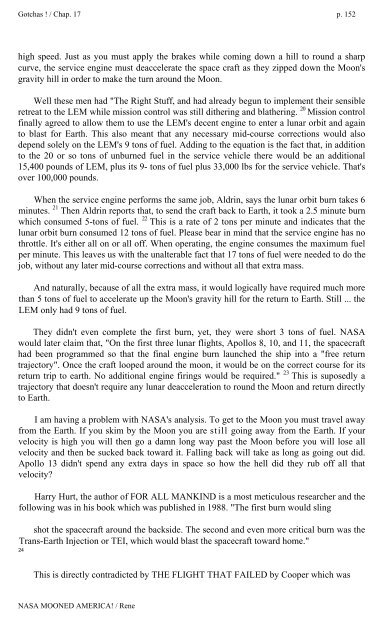Rene-NASA-Mooned-America
Rene-NASA-Mooned-America
Rene-NASA-Mooned-America
You also want an ePaper? Increase the reach of your titles
YUMPU automatically turns print PDFs into web optimized ePapers that Google loves.
Gotchas ! / Chap. 17 p. 152<br />
high speed. Just as you must apply the brakes while coming down a hill to round a sharp<br />
curve, the service engine must deaccelerate the space craft as they zipped down the Moon's<br />
gravity hill in order to make the turn around the Moon.<br />
Well these men had "The Right Stuff, and had already begun to implement their sensible<br />
retreat to the LEM while mission control was still dithering and blathering. 20 Mission control<br />
finally agreed to allow them to use the LEM's decent engine to enter a lunar orbit and again<br />
to blast for Earth. This also meant that any necessary mid-course corrections would also<br />
depend solely on the LEM's 9 tons of fuel. Adding to the equation is the fact that, in addition<br />
to the 20 or so tons of unburned fuel in the service vehicle there would be an additional<br />
15,400 pounds of LEM, plus its 9- tons of fuel plus 33,000 lbs for the service vehicle. That's<br />
over 100,000 pounds.<br />
When the service engine performs the same job, Aldrin, says the lunar orbit burn takes 6<br />
minutes. 21 Then Aldrin reports that, to send the craft back to Earth, it took a 2.5 minute burn<br />
which consumed 5-tons of fuel. 22 This is a rate of 2 tons per minute and indicates that the<br />
lunar orbit burn consumed 12 tons of fuel. Please bear in mind that the service engine has no<br />
throttle. It's either all on or all off. When operating, the engine consumes the maximum fuel<br />
per minute. This leaves us with the unalterable fact that 17 tons of fuel were needed to do the<br />
job, without any later mid-course corrections and without all that extra mass.<br />
And naturally, because of all the extra mass, it would logically have required much more<br />
than 5 tons of fuel to accelerate up the Moon's gravity hill for the return to Earth. Still ... the<br />
LEM only had 9 tons of fuel.<br />
They didn't even complete the first burn, yet, they were short 3 tons of fuel. <strong>NASA</strong><br />
would later claim that, "On the first three lunar flights, Apollos 8, 10, and 11, the spacecraft<br />
had been programmed so that the final engine burn launched the ship into a "free return<br />
trajectory". Once the craft looped around the moon, it would be on the correct course for its<br />
return trip to earth. No additional engine firings would be required." 23 This is suposedly a<br />
trajectory that doesn't require any lunar deacceleration to round the Moon and return directly<br />
to Earth.<br />
I am having a problem with <strong>NASA</strong>'s analysis. To get to the Moon you must travel away<br />
from the Earth. If you skim by the Moon you are still going away from the Earth. If your<br />
velocity is high you will then go a damn long way past the Moon before you will lose all<br />
velocity and then be sucked back toward it. Falling back will take as long as going out did.<br />
Apollo 13 didn't spend any extra days in space so how the hell did they rub off all that<br />
velocity<br />
Harry Hurt, the author of FOR ALL MANKIND is a most meticulous researcher and the<br />
following was in his book which was published in 1988. "The first burn would sling<br />
shot the spacecraft around the backside. The second and even more critical burn was the<br />
Trans-Earth Injection or TEI, which would blast the spacecraft toward home."<br />
24<br />
This is directly contradicted by THE FLIGHT THAT FAILED by Cooper which was<br />
<strong>NASA</strong> MOONED AMERICA! / <strong>Rene</strong>


